Goya is one of the classic names you think of for classic Spanish paintings. And it would be hard for Emma to resist sending along a different Goya with this one to choose from. It’s simple. Dress herself in a flowered silk shirt, on pillows like these.
https://en.wikipedia.org/wiki/La_maja_vestida
La maja vestida is a painting by Spanish painter Francisco de Goya between 1798 and 1805. It is a clothed version of La maja desnuda and is exhibited next to it in the same room at the Prado Museum in Madrid. The painting, which was first owned by Prime Minister Manuel de Godoy, who was known as an avid womanizer, was originally hung in his home in front of the naked maja in a way that the naked maja could be revealed at any time with the help of a pulley mechanism.
Here’s vestida…

And presto, here’s desnuda.
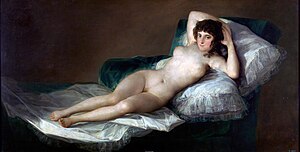
However, the smirky expression is more obvious in the nude.
This woman knows her power–and its limits.
…Goya also created another painting of the same woman identically posed, but clothed, entitled La maja vestida (“The Clothed maja“). The identity of the model and why the paintings were created are still unknown. Both paintings were first recorded as belonging to the collection of Prime Minister Manuel de Godoy, Duke of Alcudia, and it has been conjectured that the woman depicted was his young mistress. It has also been suggested that the woman was María del Pilar Teresa Cayetana de Silva y Álvarez de Toledo, 13th Duchess of Alba, with whom Goya is rumored to have been romantically involved and did complete known portraits of. However, many scholars have rejected this possibility, including Australian art critic Robert Hughes in his 2003 biography, Goya. Others believe the woman depicted is actually a composite of several different models.
In 1815, the Spanish Inquisition summoned Goya to reveal who commissioned him to create the “obscene” La maja desnuda, and he was consequently stripped of his position as the Spanish court painter. If Goya gave an explanation of the painting’s origin to the Inquisition, that account has never surfaced. Two sets of stamps depicting La maja desnuda in commemoration of Goya’s work were privately produced in 1930, and later approved by the Spanish Postal Authority. That same year, the United States government barred and returned any mail bearing the stamps.
La maja desnuda is in the collection of the Museo del Prado in Madrid and is on display next to La maja vestida in the same room.
===
Emma must have been wearing a cat suit to imitate this painting, but she would have felt impelled to include a Velasquez. I think she is beginning to push Dance’s limits, even so.
This one is unusual among works by Velasquez, because female nudes were very controlled in the period, and exhibited only in private rooms.
https://en.wikipedia.org/wiki/Rokeby_Venus
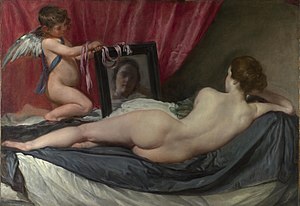
This is noted as an influence in the later painting by Manet, Olympia.
…by Diego Velázquez (1599–1660), the leading artist of the Spanish Golden Age, in the National Gallery, London. Completed between 1647 and 1651,[1] and probably painted during the artist’s visit to Italy, the work depicts the goddess Venus in an erotic pose, lying on a bed and looking into a mirror held by the god of sensual love, her son Cupid…
…The Rokeby Venus is the only surviving female nude by Velázquez. Such works were extremely rare in 17th-century Spanish art,[3] which was actively policed by members of the Spanish Inquisition. Despite this, nudes by foreign artists were keenly collected by the court circle, and this painting adorned the houses of Spanish courtiers until 1813 when it was brought to England to hang in Rokeby Park, Yorkshire…
…Intertwining pink silk ribbons are draped over the mirror and curl over its frame. The ribbon’s function has been the subject of much debate by art historians; suggestions include an allusion to the fetters used by Cupid to bind lovers, that it was used to hang the mirror, and that it was used to blindfold Venus moments before.[6] The critic Julián Gallego found Cupid’s facial expression to be so melancholy that he believes the ribbons as fetters binding the god to the image of Beauty, and gave the painting the title “Amor conquered by Beauty”….[11]…
…The Rokeby Venus may have been intended as a pendant to a 16th-century Venetian painting of a recumbent Venus (which seems to have begun life as a Danaë) in a landscape, in the same pose, but seen from the front. The two were certainly hung together for many years in Spain when in the collection of Gaspar Méndez de Haro y Guzmán (1629–87), the seventh Marquis of Carpio; at what point they were initially paired is uncertain….[27]
…Although the work is widely thought to have been painted from life, the identity of the model is subject to much speculation. In contemporary Spain it was acceptable for artists to employ male nude models for studies; however, the use of female nude models was frowned upon.[17] The painting is believed to have been executed during one of Velázquez’s visits to Rome, and Prater has observed that in Rome the artist “did indeed lead a life of considerable personal liberty that would have been consistent with the notion of using a live nude model female model”.[17]…
===
There are numerous famous classics of the Biblical story of Judith beheading Holofernes, the enemy she seduces. Many of them are restrained, clean. Not this one.
https://en.wikipedia.org/wiki/Artemisia_Gentileschi
Artemisia Gentileschi
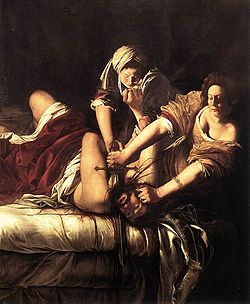
..Artemisia Gentileschi was born in Rome, on July 8, 1593, the first child of the painter Orazio Gentileschi, one of the best representatives of the school of Caravaggio. Artemisia was introduced to painting in her father’s workshop, showing much more talent than her brothers, who worked alongside her. She learned drawing, how to mix color and how to paint. Since her father’s style took inspiration from Caravaggio during that period, her style was just as heavily influenced in turn. But her approach to subject matter was different from her father’s…
…In 1612, despite her early talent, Artemisia was denied access to the all-male professional academies for art. At the time, her father was working with Agostino Tassi to decorate the vaults of Casino della Rose inside the Pallavicini Rospigliosi Palace in Rome, so Orazio hired the Tuscan painter to tutor his daughter privately. During this tutelage, Tassi raped Artemisia. Even though Tassi initially promised to marry Artemisia in order to restore her reputation, he later reneged on his promise and Orazio reported Tassi to the authorities.
In the ensuing 7-month trial, it was discovered that Tassi had planned to murder his wife, had enjoined in adultery with his sister-in-law and planned to steal some of Orazio’s paintings…
…The painting Giuditta che decapita Oloferne (Judith beheading Holofernes) (1612 – 1613), displayed in the Capodimonte Museum of Naples, is impressive for the violence portrayed, and has been interpreted as a wish for psychological revenge for the violence Artemisia had suffered…
…In Florence, Artemisia enjoyed huge success. She was the first woman accepted into the Accademia del Disegno (Academy of Drawing). She maintained good relations with the most respected artists of her time, such as Cristofano Allori, and to be able to conquer the favours and the protection of influential people, starting with Granduke Cosimo II de’ Medici and especially of the Granduchess Cristina. She had a good relationship with Galileo Galilei with whom she remained in epistolary contact for a long time. She was esteemed by Michelangelo Buonarroti the younger (nephew of the great Michelangelo): busy with construction of Casa Buonarroti to celebrate his notable relative, he asked Artemisia to produce a painting to decorate the ceiling of the gallery of paintings…
…A research paper of Roberto Longhi, an important Italian critic, dated 1916, named Gentileschi padre e figlia (Gentileschi father and daughter) described Artemisia as “the only woman in Italy who ever knew about painting, coloring, doughing and other fundamentals”. Longhi also wrote of Judith Slaying Holofernes:
Who could think in fact that over a sheet so candid, a so brutal and terrible massacre could happen […] but – it’s natural to say – this is a terrible woman! A woman painted all this?… there’s nothing sadistic here, instead what strikes the most is the impassibility of the painter, who was even able to notice how the blood, spurting with violence, can decorate with two drops the central spurt! Incredible I tell you! And also please give Mrs. Schiattesi – the conjugal name of Artemisia – the chance to choose the hilt of the sword! At last don’t you think that the only aim of Giuditta is to move away to avoid the blood which could stain her dress? We think anyway that that is a dress of Casa Gentileschi, the finest wardrobe in the Europe during 600, after Van Dyck.
Feminist studies increased the interest towards Artemisia’s artistic work and life…
…However, some art historians suggest that she was shrewdly playing on her fame from the rape trial to cater to a niche market in sexually-charged, female-dominate art for male patrons.
The most recent critic, starting from the difficult reconstruction of the entire catalogue of the Gentileschi, tried to give a less reductive reading of the career of Artemisia, placing it more accurately on the context of the different artistic environments in which the painter actively participated. A reading like this restores Artemisia as an artist who fought with determination, using the weapon of personality and of the artistic qualities, against the prejudices expressed against women painters; being able to introduce herself productively in the circle of the most respected painters of her time, embracing a series of pictorial genres which were probably more ample and varied than her paintings suggest….
…Other female painters began their career while Artemisia was alive. Judged on their artistic merits, Longhi’s statement that Artemisia was “the only woman in Italy who ever knew about painting” may be questioned, but there is no doubt that Artemisia continues to be among the most highly regarded of female artists, and has finally taken her place among the great artists of the Baroque…
She painted other Judiths as well, like this one. The maid servant looks competent too, I think.
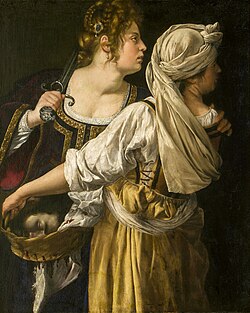
===
Emma threatens to send along a copy of Klimt’s Judith instead. He’s more often known now for “The Kiss,” but I suspect that’s possibly because–in spite of the kissing–it’s actually less obviously sexual than most of his pictures.
https://en.wikipedia.org/wiki/Gustav_Klimt
Gustav Klimt (July 14, 1862 – February 6, 1918) was an Austrian Symbolist painter and one of the most prominent members of the Vienna Art Nouveau (Vienna Secession) movement. His major works include paintings, murals, sketches, and other art objects, many of which are on display in the Vienna Secession gallery. Klimt’s primary subject was the female body,[1] and his works are marked by a frank eroticism–nowhere is this more apparent than in his numerous drawings in pencil (see Mulher sentada, below)…
…Unlike many young artists, Klimt accepted the principles of conservative Academic training. In 1877 his brother Ernst, who, like his father, would become an engraver, also enrolled in the school. The two brothers and their friend Franz Matsch began working together; by 1880 they had received numerous commissions as a team they called the “Company of Artists”. Klimt began his professional career painting interior murals and ceilings in large public buildings on the Ringstraße including a successful series of “Allegories and Emblems”.
In 1888, Klimt received the Golden order of Merit from Emperor Franz Josef I of Austria for his contributions to art. He also became an honorary member of the University of Munich and the University of Vienna. In 1892 both Klimt’s father and brother Ernst died, and he had to assume financial responsibility for his father’s and brother’s family. The tragedies affected his artistic vision as well, and soon he would veer toward a new personal style. In the early 1890s, Klimt met Emilie Flöge, who, notwithstanding the artist’s relationships with other women, was to be his companion until the end of his life. Whether his relationship with Flöge was sexual or not is debated, but during that period Klimt fathered at least 14 children…[3]
…Klimt’s ‘Golden Phase’ was marked by positive critical reaction and success. Many of his paintings from this period utilized gold leaf; the prominent use of gold can first be traced back to Pallas Athene (1898) and Judith I (1901), although the works most popularly associated with this period are the Portrait of Adele Bloch-Bauer I (1907) and The Kiss (1907 – 1908). Klimt traveled little but trips to Venice and Ravenna, both famous for their beautiful mosaics, most likely inspired his gold technique and his Byzantine imagery. In 1904, he collaborated with other artists on the lavish Palais Stoclet, the home of a wealthy Belgian industrialist, which was one of the grandest monuments of the Art Nouveau age. Klimt’s contributions to the dining room, including both Fulfillment and Expectation, were some of his finest decorative work, and as he publicly stated, “probably the ultimate stage of my development of ornament.”[8] Between 1907 and 1909, Klimt painted five canvases of society women wrapped in fur. His apparent love of costume is expressed in the many photographs of Flöge modeling clothing she designed…
…Klimt’s work is distinguished by the elegant gold or coloured decoration, often of a phallic shape that conceals the more erotic positions of the drawings upon which many of his paintings are based. This can be seen in Judith I (1901), and in The Kiss (1907–1908), and especially in Danaë (1907). One of the most common themes Klimt utilized was that of the dominant woman, the femme fatale. Art historians note an eclectic range of influences contributing to Klimt’s distinct style, including Egyptian, Minoan, Classical Greek, and Byzantine inspirations. Klimt was also inspired by the engravings of Albrecht Dürer, late medieval European painting, and Japanese Rimpa school. His mature works are characterized by a rejection of earlier naturalistic styles, and make use of symbols or symbolic elements to convey psychological ideas and emphasize the “freedom” of art from traditional culture…
…As he worked and relaxed in his home, Klimt normally wore sandals and a long robe with no undergarments. His simple life was somewhat cloistered, devoted to his art and family and little else except the Secessionist Movement, and he avoided café society and other artists socially. Klimt’s fame usually brought patrons to his door, and he could afford to be highly selective. His painting method was very deliberate and painstaking at times and he required lengthy sittings by his subjects. Though very active sexually, he kept his affairs discreet and he avoided personal scandal. Like Rodin, Klimt also utilized mythology and allegory to thinly disguise his highly erotic nature, and his drawings often reveal purely sexual interest in women as objects. His models were routinely available to him to pose in any erotic manner that pleased him. Many of the models were prostitutes as well.
Klimt wrote little about his vision or his methods. He wrote mostly postcards to Flöge and kept no diary. In a rare writing called “Commentary on a non-existent self-portrait”, he states “I have never painted a self-portrait. I am less interested in myself as a subject for a painting than I am in other people, above all women…There is nothing special about me. I am a painter who paints day after day from morning to night…Who ever wants to know something about me… ought to look carefully at my pictures.”…[9]…
He has some interesting images, under the circs. Hygeia is very interesting, a very strong figure.
But this one is called Water Snakes, or the Hydra.

From another online source, quite a different color copy, and the info 1904
Klimt paints “Water Snakes” and is commissioned to paint the series of mosaic murals (1905-1909) for the Palais Stoclet, an opulent private mansion in Brussels.
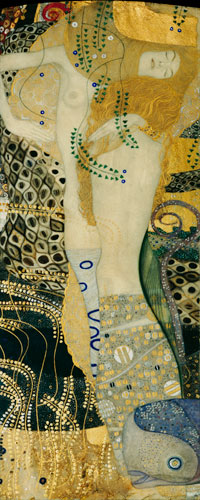
There’s a rude review by Tom Lubbock of his work here, in London’s “The Independent“, from a recent Tate exhibit:
..Reality does not intrude. Design conquers all. Pattern, ornament, outlandish and incredible shape-making, override every resistance. You see it in his treatment of the human figure. Look at the roll-mopped bodies of the nymphs in the last scene of the frieze, or the almost illegibly flattened and attenuated forms of the lesbian mermaids in Water Snakes – they might be sheets of pastry, to be stretched wide or folded over or cut out anyhow…
..But seriously: what’s it about, all this flagrant artifice? Yes, it’s a dramatic turn against realism, and Klimt is not alone in that among late 19th-century artists. But I can’t see that his anti-realism about anything much – apart from making things look neater, less complicated, more stylish.
His art excludes all rough energies. It reduces the world to a beautiful consistency. Beyond that seems to be an utterly blank, unmotivated artist. The famous Kiss is quite passionless. Nothing drives him, not even sex.
Obviously, he’s interested in sex. There’s a wall here of his watery pencil-drawings, in which women open their legs and masturbate. And his paintings are occasionally sexy, but their sexiness is a matter of expertise. Klimt belongs to the Mr Spock school of pornography. He knows what turns on the human male, and he presses the right buttons – cascading tresses, pneumatic bottoms – without apparently sharing in the desires he inflames.
So don’t talk wisely about “the Vienna of Freud” and the birth of psychoanalysis. A far more relevant reference would be to an older Viennese institution – the Spanish Riding School. As in formal equestrianism, what you see in Klimt is the gratuitous triumph of design over life.
Compare Klimt to that other star of Art Nouveau, the English illustrator Aubrey Beardsley. His art is just as artificial – but he knows how outrageous his shape-making is, as well as exquisitely beautiful. There’s a sophisticated irony at play in Beardsley – life is only made fine through the most absurd pretences.
Nothing like that crosses Klimt’s mind. He just likes the way it all looks so smart. He’s basically thick. But when you start to compare Klimt and Beardsley line for line, the contrast really bites. You realise how much Klimt gains from reproduction – and reduction. Make his images small, and their lines look taut and definite. At actual size, you see how approximate and uncertain they are. On any scale, Beardsley’s draughtsmanship is as tense as a tight-rope walker…
===
The Nightmare is a 1781 oil painting by Swiss artist Henry Fuseli (1741–1825).
Interpretation of The Nightmare has varied widely. The canvas seems to portray simultaneously a dreaming woman and the content of her nightmare. The incubus and the horse’s head refer to contemporary belief and folklore about nightmares, but have been ascribed more specific meanings by some theorists. Contemporary critics were taken aback by the overt sexuality of the painting, which has since been interpreted by some scholars as anticipating Freudian ideas about the subconscious…
…For contemporary viewers, The Nightmare invoked the relationship of the incubus and the horse (mare) to nightmares. The work was likely inspired by the waking dreams experienced by Fuseli and his contemporaries, who found that these experiences related to folkloric beliefs like the Germanic tales about demons and witches that possessed people who slept alone. In these stories, men were visited by horses or hags, giving rise to the terms “hag-riding” and “mare-riding”, and women were believed to engage in sex with the devil.[3] The etymology of the word “nightmare”, however, does not relate to horses. Rather, the word is derived from mara, a Scandinavian mythological term referring to a spirit sent to torment or suffocate sleepers. The early meaning of “nightmare” included the sleeper’s experience of weight on the chest combined with sleep paralysis, dyspnea, or a feeling of dread.[4] The painting incorporates a variety of imagery associated with these ideas, depicting a mare’s head and a demon crouched atop the woman…
He painted several later versions, but I think this is the one Emma used.

Contemporary critics often found the work scandalous due to its sexual themes. A few years before he painted The Nightmare, Fuseli had fallen passionately in love with a woman named Anna Landholdt in Zürich, while he was traveling from Rome to London. Landholdt was the niece of his friend, the Swiss physiognomist Johann Kaspar Lavater. Fuseli wrote of his fantasies to Lavater in 1779:
Last night I had her in bed with me—tossed my bedclothes hugger-mugger—wound my hot and tight-clasped hands about her—fused her body and soul together with my own—poured into her my spirit, breath and strength. Anyone who touches her now commits adultery and incest! She is mine, and I am hers. And have her I will.…[9]
Fuseli’s marriage proposal met with disapproval from the woman’s father, and in any case Fuseli’s love seems to have been unrequited—Landholdt married a family friend soon after. The Nightmare, then, can be seen as a personal portrayal of the erotic aspects of love lost. Art historian H. W. Janson suggests that the sleeping woman represents Landholdt and that the demon is Fuseli himself. Bolstering this claim is an unfinished portrait of a girl on the back of the painting’s canvas, which may portray Landholdt. Anthropologist Charles Stewart, in his study of erotic dreams and nightmares, characterizes the sleeping woman as “voluptuous,”[4] and one scholar of the Gothic describes her as lying in a “sexually receptive position.”[10] In Woman as Sex Object (1972), Marcia Allentuck similarly argues that the painting’s intent is to show female orgasm. This is supported by Fuseli’s sexually overt and even pornographic private drawings (e.g., Symplegma of Man with Two Women, 1770–78).[3] Fuseli’s painting has been considered representative of sublimated sexual instincts.[2] Related interpretations of the painting view the incubus as a dream symbol of male libido, with the sexual act represented by the horse’s intrusion through the curtain.[11]…
===
Manet’s 1863 painting Olympia shocked people at the time by being too realistic about things. Manet’s Olympia was, and is, a pretty rude picture.
https://en.wikipedia.org/wiki/Olympia_(painting)
One imagines the client was rude to begin with. The servant holds flowers. The courtesan is Not Impressed.
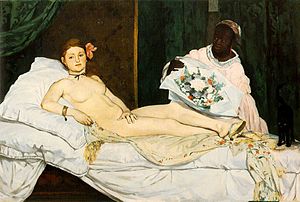
…What shocked contemporary audiences was not Olympia’s nudity, nor even the presence of her fully clothed maid, but her confrontational gaze and a number of details identifying her as a demi-mondaine or courtesan. These include the orchid in her hair, her bracelet, pearl earrings and the oriental shawl on which she lies, symbols of wealth and sensuality. The black ribbon around her neck, in stark contrast with her pale flesh, and her cast-off slipper underline the voluptuous atmosphere. Whereas Titian’s Venus delicately covers her sex, Olympia’s hand firmly protects hers, as if to emphasize her independence and sexual dominance over men. Manet replaced the little dog (symbol of fidelity) in Titian’s painting with a black cat, which symbolized prostitution. Olympia disdainfully ignores the flowers presented to her by her servant, probably a gift from a client. Some have suggested that she is looking in the direction of the door, as her client barges in unannounced…
===
In talking about Manet’s Olympia, Emma references the woman who is the model, Victorine Meurent.
https://en.wikipedia.org/wiki/Victorine_Meurent
Probably one of the more interesting pictures of her:

..Victorine Louise Meurent (1844–1927) was a French painter and a famous model for painters. Although she is now best known as the favorite model of Édouard Manet, she also was an artist in her own right, who exhibited repeatedly at the prestigious Paris Salon. In 1876 her paintings were selected for inclusion at the juried exhibition, when Manet’s work was not…
..e of sixteen in the studio of Thomas Couture. She first worked for Manet in 1862, posing for a painting entitled, The Street Singer. Manet was first drawn to Victorine when he saw her in the street, carrying her guitar. Victorine was particularly noticeable for her petite stature and her red hair, which is depicted as very bright in Manet’s watercolour copy of “Olympia”. As well as playing the guitar, Victorine also played the violin, gave lessons in the two instruments, and sang in cafe’-concerts. Her name remains forever associated with Manet’s masterpieces, The Luncheon on the Grass and Olympia, which include portraits of her. During this time period she also modelled for Belgian painter Alfred Stevens and Degas, both close friends of Manet. Her relationship with Stevens is said to have been particularly close. Manet continued to use Victorine Meurent as a model until the early 1870s, when she began taking art classes and they became estranged, as Victorine was drawn to the more academic style of painting against which Manet’s work was in opposition…
…By 1906, Meurent had left Paris for the suburb of Colombes, where she lived with a woman named Marie Dufour for the remainder of her life. The two appear to have shared ownership of their house. Meurent died on March 17th, 1927. After the death of Dufour, in 1930, the contents of the house were liquidated; in the late 20th C., elderly neighbours recalled the last contents of the house, including a violin and its case, being burnt on a bonfire.
A painting by Meurent was recovered in 2004 and now hangs in the Colombes History Museum…
…Meurent in Fiction
The Irish writer George Moore included Meurent as a character in his semi-fictional autobiography, Memoirs of My Dead Life. She appears as a middle-aged woman past her prime, living in a lesbian relationship with a famous courtesan. More recently, Victorine Meurent’s life has inspired a historical novel, Mademoiselle Victorine by Debra Finerman. She also appears as a character in a film called Manet in Love. Both works involve Meurent as Manet’s mistress.
===
Some reference links to Wikipedia on the paintings, in much the way Drin would dig them up from the images sent him by Emma in “Postcards”.